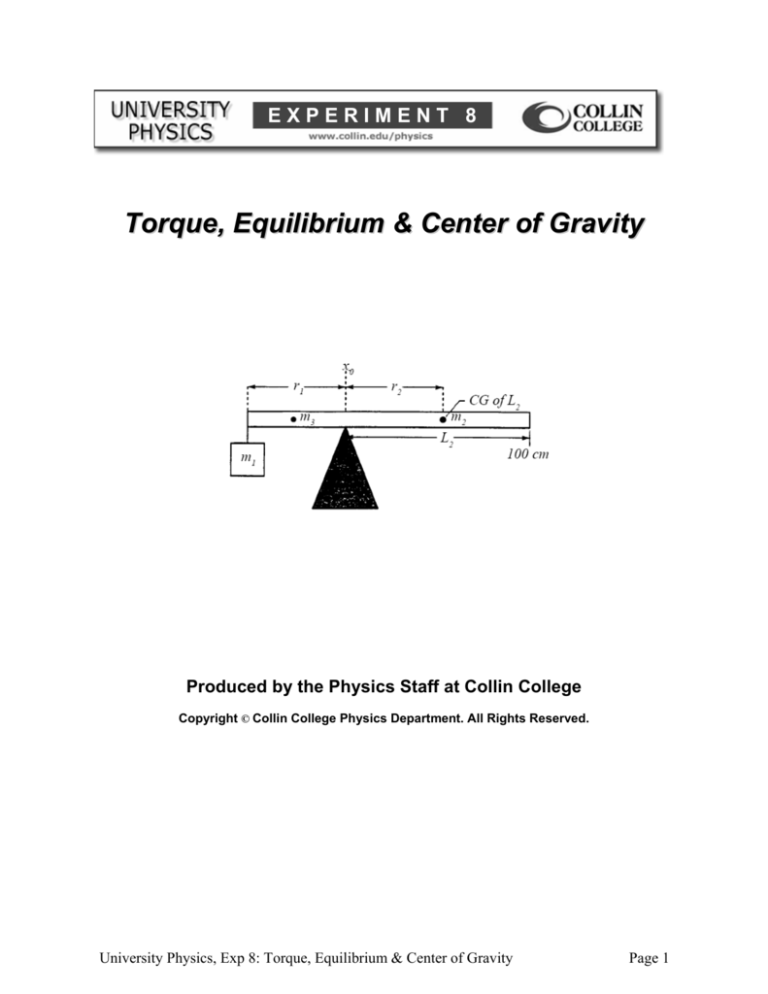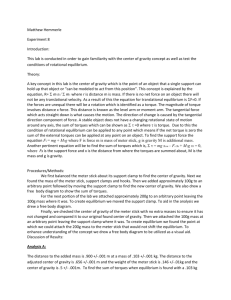
EXPERIMENT 8
Torque, Equilibrium & Center of Gravity
Produced by the Physics Staff at Collin College
Copyright © Collin College Physics Department. All Rights Reserved.
University Physics, Exp 8: Torque, Equilibrium & Center of Gravity
Page 1
Purpose
In this experiment, you will investigate torques on rigid bodies and static equilibrium.
Equipment
•
•
•
•
•
•
1 Lab Balance
1 Meter stick
1 Balance Stand for meter stick
1 Set of Mass Hangers for meter stick
1 Hooked Mass Set
1 Small, Unknown Metal Mass
Introduction
Consider, for example, an ordinary chair. It appears to be a rigid body. Is it in equilibrium as
it sits on the floor? If, as often happens, one of its legs is a bit short, it will not be in
equilibrium; instead, it will wobble about the two diagonally-opposite longer legs. But if an
elephant sits on the chair, it will most definitely be in equilibrium with all four legs resting
solidly on the floor.
What has changed? Only the chair’s shape. The elephant has distorted it. It is not a rigid body
under these conditions.
In this experiment, you will investigate truly rigid bodies and static equilibrium. The static
equilibrium condition is very important in civil engineering, applying to bridges, dams,
buildings, statues, and balconies, and in our daily lives, applying to our ability to stand up, to
drive around corners without overturning, and to slide a stein of beer the length of the bar
without spilling it.
Analyzing static equilibrium conditions is an essential part of architectural engineering. The
designer needs to identify all the forces and torques that act on a structural element, and to
ensure through design and materials selection that the element will safely tolerate the loads to
be exerted on it.
Two conditions must be met for a rigid object subject to a combination of external forces to
be in mechanical equilibrium:
1. The vector sum of all the external forces acting on it must be zero. Translational
G
equilibrium: ∑ F = 0
2. The vector sum of all the torques about an arbitrary axis must be zero. Rotational
G
equilibrium: ∑τ = 0 . To be in static equilibrium, a rigid object must also be in
rotational equilibrium.
The concept of center of mass is what allows us to study the motion and equilibrium of
extended (real world) objects as if they were point objects. By considering the translational
motion of an object’s center of mass (the motion of a point mass), and the rotational motion of
University Physics, Exp 8: Torque, Equilibrium & Center of Gravity
Page 2
the object about its center of mass, we can determine the complex motion of any extended
object.
In this experiment, you will examine torques, rotational equilibrium, and center of mass as
they apply to a rigid object. The rigid object will be an ordinary wooden meter stick. By
measuring the forces and calculating the torques acting on this meter stick in different
situations, you will experimentally verify the two equilibrium equations. In doing this, you
will learn to
1. Describe mechanical equilibrium of a rigid object
2. Explain the center of mass concept
3. Explain how a laboratory balance measures mass
Theory
Equilibrium
A rigid body in static equilibrium must necessarily be in rotational equilibrium. Torque about
some axis of rotation (also called moment of force) results from a force being exerted at a
point not on the axis. Torque is defined as the vector product of the force and the
displacement to the axis:
G G
G
τ = F ×r
Therefore, the magnitude of the torque is
τ = Fr sin θ
The measurement unit for torque is the newton-meter (Nm), which you should not confuse
with the unit of work (1 newton-meter = 1 joule).
Torque is a vector quantity. Its direction is normal to the plane containing r and F. When you
cross r into F using the right-hand rule, your thumb points in the direction of the torque. For
convenience, torques are designated by the circular directions of motion that they tend to
cause (clockwise and counter-clockwise)
A rigid body can rotate about a specific axis in only two directions, clockwise or counterclockwise. Clockwise torques produce clockwise rotational motion and counterclockwise
torques cause counterclockwise rotational motion. Rotation will not begin or change if the
applied torques are balanced (if the system is in rotational equilibrium). The condition for
rotational equilibrium is
G
G
∑τ = ∑τ
ccw
G
+ ∑τ cw = 0
G
G
where τ ccw and τ cw are the counterclockwise and clockwise torques. Conventionally, the
counterclockwise direction is positive, and the clockwise direction is negative.
University Physics, Exp 8: Torque, Equilibrium & Center of Gravity
Page 3
For the system in Figure 8.1, the condition for rotational equilibrium becomes:
F1r1 = F2 r2 + F3r3
In this case the counterclockwise torque is F1r1 and the clockwise torques are F2r2 and
F3r3. Note that the forces Fi may also be expressed as weights according to Newton’s Second
Law (Wi = Fi = mg). In this equation, the weight W has units of N, the mass m is in kg, and the
gravitational acceleration g is in m/s2.
You can use the equation of balanced torques to find an unknown quantity such as a moment
arm. Assume the bar above is in static equilibrium and the forces exerted on the bar are due to
three masses hanging at the indicated positions. Then
m1r1 = m2 r2 + m3r3
or r1 =
m2 r2 + m3r3
m1
If m2 = m3 = 100g, m1 = 200g, r2 = 40cm, and r3 = 60cm, r1 must be
r1 =
100g(40cm) + 100g(60cm)
= 50cm
200g
Center of Gravity
The center of gravity of an object is the point where all of the weight of that object (mg) may
be concentrated for the purpose of determining the torque gravity exerts on it. The weights of
the infinitesimal mass particles making up a rigid object create torques about the object’s
center of gravity. A wooden meter stick of uniform cross section, for example, may be
considered as made up of many point masses that are in rotational equilibrium about its center
of gravity at the 50 cm point. The ruler can be balanced (supported in rotational equilibrium)
on a fulcrum located at its center of gravity.
The center of mass of this same ruler would be at the same location as its center of gravity as
long as the acceleration due to gravity g is uniform. For a symmetrical stick with a uniform
mass distribution, its center of mass and its center of gravity will both be located at its center
of symmetry.
University Physics, Exp 8: Torque, Equilibrium & Center of Gravity
Page 4
The concept of linear mass density u is closely related to the concept of uniform mass
distribution. The linear mass density of a rigid object is defined as its mass per unit length:
μ=
m
L
If a meter stick has a mass of 150 g, its linear mass density becomes 150 g /100 cm = 1.50
g/cm = 0.15 kg/m. Assuming a uniform mass distribution for the ruler, every centimeter of it
has a mass of 1.50 g, and 60 cm would have 90 g of mass. Keep in mind, however, that
laboratory 1-m rulers do not necessarily have uniform mass distribution, especially older ones
that are worn on their edges, and such an assumption gives only approximate values.
Procedure
You will use minimal equipment and no computer sensors in this experiment. In hanging
masses from the meter stick, you may suspend them from sliding clamps with hangers or from
loops of string. Suspending the hooked masses from loops of string (or rubber bands) is easier
since you can consider the strings to be massless. If you use the clamps with hangers, be sure
that you add their masses to the hanging mass.
A. Rigid Rod Supported at its Center of Gravity
1. Measure the mass of the meter stick and record its value above Data Table 8.1.
Case 1. Two masses of known value
2. Supporting the meter stick at its center of mass (point where the meter stick is
balanced by itself), hang a 100 g mass at the 20 cm point. Record this mass m1 and its
moment arm r1 in Table 8.1.
3. Balance the ruler by placing a 200 g mass at an appropriate location on the other side
of the fulcrum. Record this mass m2 and its moment arm r2 in Table 8.1.
4. Calculate and record the CW and CCW torques and the percent difference between
them.
Case 2. Three masses of known value
5. With the ruler still supported at its center of mass, hang a 100 g mass m1 at the 15 cm
mark and a 200 g mass m2 at the 75 cm mark. Hang a 50 g mass m3 at the appropriate
position so the ruler is in static equilibrium. Record all masses and moment arms in
Table 8.1.
6. Compute and record the torques and percent differences as you did in step 4.
B. Rigid Rod Supported at Different Points
In Part A, you did not take the mass of the ruler itself into account because the support was
located at its center of gravity, and the torque due to its weight was zero.
University Physics, Exp 8: Torque, Equilibrium & Center of Gravity
Page 5
In this part, the ruler will not be supported at its center of gravity but at other pivot points
indicated in general in Figure 8.2. For these cases, you will have to consider the weight of the
ruler and compute appropriate torques for each case due to m2 and m3.
1. Hang a 100 g mass m1 near the zero end of the ruler and slide the support to the
appropriate position to achieve static equilibrium. Record the mass and moment arm in
Table 8.2.
2. Assuming uniform mass distribution of the ruler, calculate and record the mass m2 of
L2.
3. Calculate and record the moment arm r2.
4. For the same setup, calculate and record the moment arm r3 due to the mass m3 of that
portion of the ruler on the other side of the support.
5. Calculate and record the torques and percent differences as you did in Part A.
C. Center of Gravity
1. Tape an unknown mass near one end of the ruler as shown in Figure 8.3. Keep the
mass at the same position for the rest of this part.
2. Measure the mass mr of the loaded ruler and record it under Data Table 8.3.
3. The center of gravity of the loaded ruler is now at point C. Balance the loaded ruler
and record the exact position of point C in Table 8.3.
4. Hang a mass m1 of arbitrary value from point A near the other end of the ruler. Adjust
the support point of the loaded ruler from C to B until the ruler is again in static
equilibrium (see Figure 8.4). Record the value of m1 and the moment arms L and x in
Table 8.3 (the weight W of the loaded ruler is considered as acting at point C a
distance x from the pivot).
University Physics, Exp 8: Torque, Equilibrium & Center of Gravity
Page 6
5. Calculate and record the torques and percent differences as you did in Part A.
6. Disassemble the equipment and return it to the lab cart. Clean up around your lab table
area.
University Physics, Exp 8: Torque, Equilibrium & Center of Gravity
Page 7









